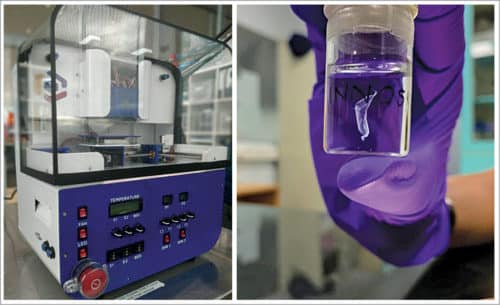The medical world has been able to find remedies for most issues that were once life-threatening for mankind in the past century and some of it, if not all, could be truly possible due to rapid advancements in technology. Since the first-ever successful organ transplant, great improvements have been made to increase the success rate of transplants. But the problem is that organ supply is not enough to suffice the demand, causing deaths from vital organ failure. 3D printing is being seen as the solution to this issue by researchers across the globe.
Next Big Innovation Labs, a Bengaluru startup founded in 2016, is working to develop innovative products and services for research and development and clinical applications in this field. The team was awarded the Idea2POC grant as well as the Biotech Ignition grant under the BIRAC scheme in 2017. The founders initially began making maxillofacial 3D models for doctors with the help of patient-specific scans.
After realising the need for customisable implants, the team started out with a long-term aim to eliminate the demand-availability gap through 3D bioprinting. In this type of additive manufacturing, biomaterials like cells and other biocompatible materials are combined to form bioinks. After testing the suitability of bioinks, these are then printed to generate bodily structures such as tissues and organs that imitate natural ones.
The company launched its first product, the bioprinter Trivima, meaning three-dimensional in Sanskrit, at Bengaluru Tech Summit in 2018. The design of most machine components was done using Autocad Fusion 360. The precise, customisable and lightweight 3D bioprinter specifically caters to the research requirements of individuals in the field of 3D bioprinting. Some examples include the development of tissue disease models and 3D printed scaffolds, stem cell research, and the like. The possibility of varying print speed, temperatures, nozzle diameters, and parameters in various mechanisms helps researchers in better investigation of their topic of interest, which is not present in many other bioprinters in the market.
The startup has already expanded its business by setting up offices in Germany in 2018 and it looks forward to more such opportunities. It has also developed Innoskin human epidermis (HE) using its patented 3D bioprinting technology, which is the first in the series of Innoskin products. Innoskin FT, which is the other variant, consists of dermal and epidermal components of the skin.

The challenge was to use the right materials that could combine to form human skin. The product can replace animal testing for cosmetic, chemical, agrochemical, and pharmaceutical sectors working on skin-related applications, which is the current standard method in most places. The company plans to offer it later on for clinical applications where 3D bioprinted tissue can be used as a skin graft to treat skin injuries, burn victims and other skin related damages.
Fully functional bioprinted organs will need to clear the necessary guidelines before being used as a transplant. But once this becomes successful, it will have a huge impact on the lives of common people by increasing availability and affordability.













